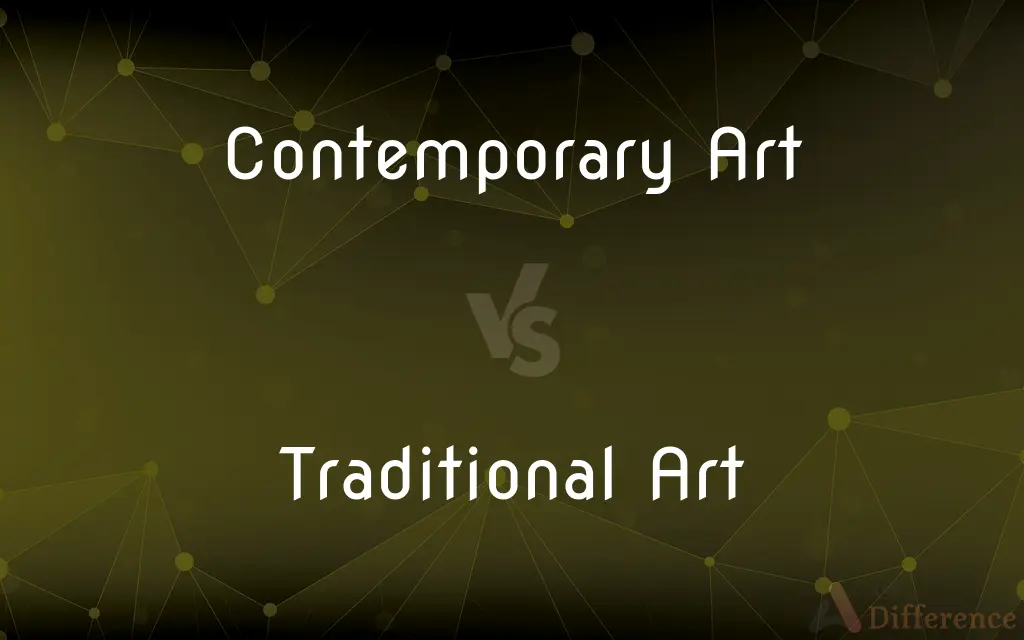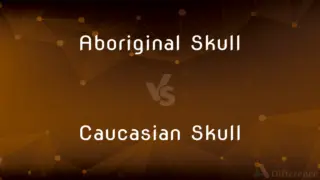Contemporary Art vs. Traditional Art — What's the Difference?
By Tayyaba Rehman — Published on November 4, 2023
Contemporary Art reflects current cultures and ideas; Traditional Art adheres to established methods and styles.

Difference Between Contemporary Art and Traditional Art
Table of Contents
ADVERTISEMENT
Key Differences
Contemporary Art is fluid, reflecting the evolving tastes, cultures, and societal values of the current period. This art form often challenges the status quo, experimenting with new mediums and concepts. In contrast, Traditional Art is rooted in established techniques, often handed down through generations, and primarily focuses on established aesthetic values and norms.
Contemporary Art often seeks to spark dialogue or elicit emotional responses, pushing boundaries and embracing the avant-garde. Artists may utilize multimedia installations, abstract forms, or digital methods. On the other hand, Traditional Art, such as classical painting or sculpture, emphasizes time-honored techniques, reflecting historical or cultural themes in predictable ways.
Contemporary Art, by its nature, is ever-changing, with what's considered "contemporary" shifting with each generation. This art form is often influenced by global events, technological advancements, or social movements. In contrast, Traditional Art stands as a testament to historical techniques, preserving the aesthetics of bygone eras and often prioritizing beauty and formality.
Contemporary Art can sometimes be challenging to understand without context, as it often reflects intricate societal nuances or personal expressions. Traditional Art, however, generally offers more immediate visual appeal, rooted in universally recognized styles or themes. While Contemporary Art challenges viewers to think and interpret, Traditional Art often comforts with its familiarity.
Comparison Chart
Time Period
Current era
Historical eras
ADVERTISEMENT
Themes
Current issues/events
Historical/cultural themes
Techniques
Experimental
Established techniques
Purpose
Elicit emotion/dialogue
Reflect established aesthetics
Recognition
Might require context
Universally recognized
Compare with Definitions
Contemporary Art
Ever-evolving art form shifting with generations.
What was Contemporary Art in the '90s differs greatly from today.
Traditional Art
Art rooted in long-standing techniques and styles.
The museum showcased Traditional Art from ancient Greece.
Contemporary Art
Art reflecting current societal values and ideas.
The gallery's Contemporary Art collection captures today's political climate.
Traditional Art
Pieces created using time-honored methods.
Pottery made on a wheel is a form of Traditional Art.
Contemporary Art
Art born from current events, technology, or social movements.
Virtual reality has influenced many Contemporary Art pieces.
Traditional Art
Art offering universal appeal and familiarity.
Tourists often buy Traditional Art as souvenirs due to its recognizable nature.
Contemporary Art
Works challenging traditional conventions and aesthetics.
Her abstract sculptures redefine Contemporary Art standards.
Traditional Art
Works reflecting historical or cultural themes.
Her painting is reminiscent of Traditional Art from the Renaissance.
Contemporary Art
Art pushing boundaries in medium and concept.
His use of recycled materials brings a fresh perspective to Contemporary Art.
Traditional Art
Art emphasizing beauty, formality, and recognized aesthetics.
Traditional Art often prioritizes symmetry and proportion.
Common Curiosities
Why is Traditional Art considered "traditional"?
It preserves techniques and aesthetics from past eras.
What is Contemporary Art?
Art reflecting current societal values, trends, and technologies.
How does Traditional Art differ?
It's rooted in established techniques and historical themes.
Is Contemporary Art always abstract?
No, but it often challenges conventional aesthetics and ideas.
What are common themes in Traditional Art?
Historical events, cultural stories, and established aesthetics.
Is Traditional Art limited to paintings and sculptures?
No, it encompasses various mediums but with time-honored techniques.
Why is Traditional Art popular among tourists?
Its familiarity and reflection of a region's cultural heritage.
Does Contemporary Art change over time?
Yes, what's considered "contemporary" evolves with societal shifts.
Why might Contemporary Art be hard to understand?
It often requires context and reflects intricate societal nuances.
Can Traditional Art evolve?
While rooted in history, artists can provide fresh takes on traditional themes.
Why is it essential to understand both Contemporary and Traditional Art?
Both offer insights into human expression across time and context.
Can a piece be both Contemporary and Traditional Art?
Yes, if it merges current ideas with established methods.
Does Contemporary Art have global influences?
Yes, globalization has led to diverse influences in Contemporary Art.
How do museums differentiate Contemporary and Traditional Art?
Often by the era, technique, and themes the art pieces represent.
How do artists influence Contemporary Art?
By interpreting current events, technologies, and societal changes.
Share Your Discovery

Previous Comparison
Aboriginal Skull vs. Caucasian Skull
Next Comparison
Inkjet Printer vs. Laser PrinterAuthor Spotlight
Written by
Tayyaba RehmanTayyaba Rehman is a distinguished writer, currently serving as a primary contributor to askdifference.com. As a researcher in semantics and etymology, Tayyaba's passion for the complexity of languages and their distinctions has found a perfect home on the platform. Tayyaba delves into the intricacies of language, distinguishing between commonly confused words and phrases, thereby providing clarity for readers worldwide.
















































